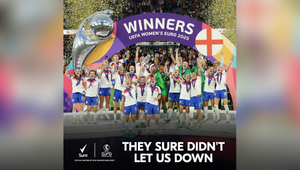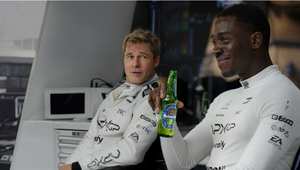
How Edelman Challenged a 100-Year Accepted Standard in the Frozen Food Supply Chain

Did you know that in cold chain shipping (AKA the shipping of frozen foods around the world), the standard temperature is -18°C? Not for any reason other than because when translated into Fahrenheit, it rounds down to 0°F.
Upon finding out that there is no modern scientific backing to cooling goods to -18°C, Edelman embarked on its ‘Move to -15°C’ – a campaign in collaboration with longtime client and cold chain giant DP World that would subsequently reduce cost and cut carbon emissions in the sector massively.
Edelman has been DP World’s lead agency for more than four years now – a journey that took the two companies everywhere, from Formula 1, to the WEF stage at Davos and beyond. This relationship allowed Edelman to build a deep knowledge of the cold chain business, which in turn made this groundbreaking project possible. “We operated hand in hand with DP World throughout, including when they made the brave decision to spin off the ‘Move to -15°C’ as a separate entity, so it could operate independently,” says the Edelman team.
In fact, the project was born when Edelman was asked to create a campaign that would make people in the UK more aware of DP World’s role in cold chain shipping. As part of the planning, the team conducted research to better understand how frozen food shipping really works, only to be left surprised by the excessively low temperature of shipping, with no good reason behind it.
Lots of conversations with the client followed – as well as with others in the industry – about what it would take to make a change. “We realised that it would require the whole industry moving together. And so, the ‘Move to -15°C’ coalition was born,” explains the team.
The project managed to team up scientists and independent experts to be able to nail the new possible temperature, while making international cold chain giants work together for the better of the planet and their industry. A well deserved Titanium Lion followed last June as a result.
Here, Karin Robinson, senior strategy director, Edelman London, Mary Pollard, executive director, Edelman Impact and ESG, Edelman UK, Andy Bloxham, head of corporate strategy, Edelman London and Emma De La Fosse, chief creative officer, Edelman UK break down the complicated project.
LBB> To make this project work, you had to involve other companies and, as the case study film says, make competitors work together. How did you achieve this and were there any challenges?
Edelman> The ‘Move to -15°C’ campaign is about bringing together a diverse industry, full of companies who have previously been competitors, to collectively enact a temperature transition across the entire cold chain.
This aim was fundamental in shaping our creative response. We understood that to bring everyone on the journey, we needed to create space for them to be a part of it.
With the DP World voice, the branding was too strong and overt – it would’ve discouraged other brands from getting involved. So, unusually, we dialled the branding in all our communications down. And we are continuing to do that as ‘The Move to -15°C’ coalition grows and evolves.
How DP World as a company was involved was critical too, as our actions had the potential to drive trust. Proprietary research and data is incredibly valuable to a company. But in our case it was more valuable to make it freely available to the industry if we were to convince them that our 3°C temperature change proposal was robust. Writing an open letter, inviting the world’s largest shipping, refrigeration and food companies to join the ‘Move to -15°C’, showed a fresh, more collaborative approach to sustainability.
The creative platform had to support all these different aspects of the campaign. But first and foremost, the idea needed to simply and clearly convey to our audience what it was that DP World was proposing.
It may sound straightforward, but remember the context – we planned to launch at COP28, a climate convention, and rising temperatures are generally bad news. We had to communicate that raising the temperature was going to be positive. It’s also difficult to talk about the positives of changing negative numbers.
While the facts and information were important in busting through inertia, emotion played a critical role too and that isn’t something we often talk about in B2B. The creative platform had to launch a movement, to inspire others with a sense of what’s possible. From the key visual used across all our media to the COP28 launch film, the work conveyed magnitude and momentum to galvanise people into action.
LBB> Tell me about the research. Who did you collaborate with for it, how long did it take?
Edelman> We contracted an international panel of independent experts in the cold chain to look into two big questions for us. Would it be safe to ship and store food at a higher temperature? And what would be the impact on carbon and energy use if we did?
The research team was led by professor Toby Peters, co-director of the Centre for Sustainable Cooling at the University of Birmingham, and also included:
Dr Yosr Allouche, head of the International Institute of Refrigeration, an expert in food refrigeration.
Prof Judith Evans, London South Bank University who is an expert in refrigeration and frozen storage.
Dr Tim Fox, IMechE for his specialism in climate change mitigation and adaptation.
Prof Peter Fryer, University of Birmingham who focuses on food structure, manufacture and processes.
Dr Natalia Falagan, Cranfield University whose interest area is food science, safety and consumer perception.
Prof Phil Greening, Heriot-Watt University, Centre for Sustainable Road Freight, who is a logistics expert.
Dr Leyla Sayin, University of Birmingham, a specialist in socio-economic modelling.
This distinguished team told us that the temperature could safely be raised from -18°C to -15°C. And that doing so would save between 5- 7% of the energy used in the process, reducing costs while cutting carbon.
LBB> When you were able to firmly tell from the research that the temperature could safely be lowered by 3°C, what were the next steps to implementation and how did you manage this?
Edelman> We knew that to make this change, we needed the whole industry to come together, so forming a coalition of all the businesses involved in the frozen food supply chain, from farm, to ship, to shop was the right way forward. And we knew that we would have a big moment of opportunity as DP World was a Principal Pathway Partner to COP28, which was being held that year in Dubai. But since the research was only completed a couple months ahead of COP28, we had to move at pace to prepare the campaign for launch in a matter of weeks.
LBB> Can you explain to our readers, why 3°C and not less or more? Is there a likelihood of lowering this temperature even further?
Edelman> Below -12°C, all microbial activity drops to a minimum, meaning the food stays fresh and stops decaying. But in the process of shipping, food routinely warms and cools by a few degrees as it moves in and out of storage. A standard temperature of -15°C degrees is enough to provide a buffer against these fluctuations and ensure that food safety and quality is not affected.
Could this temperature be reduced even further in the future? Maybe! The technology and infrastructure to trace and monitor food temperature is improving all the time.
The conversation we’ve generated between members also means we are identifying markets and commodities where excessively cooling below -18°C routinely takes place, meaning there may be places where we can make a change of more than three degrees with an even greater impact.
LBB> What were the biggest challenges, and how did you overcome them? And what was the most rewarding part of the project?
Edelman> The biggest challenge with trying to overturn an industry standard that has been in place for a century is overcoming inertia – the status quo is a powerful thing. And in this case, since no one business could make the change on their own, it was all too easy to believe that nothing could be done.
Only someone with the size and scale of DP World had the right networks and reach to bring everyone together. But that was never going to be an easy thing to do, and the work of the ‘Move to -15°C’ is still a steep hill to climb.
Having said that, we are delighted that the coalition is already making preparations to move food at the new temperature this year. Change is possible.
The complexity of this challenge is what makes the result so gratifying. At Edelman, we profoundly believe that trust is built through meaningful action. Nothing that you say is as powerful as what you do. And no agency has ever been able to help drive a potential change a global standard in this way.
LBB> The campaign and project won a Titanium Lion, making Edelman the first legacy PR firm to ever receive this prize. What do you think made this project a winning one in the category?
Edelman> The Titanium award is intended for work that in the eyes of the judges “break(s) new ground in communications with provocative, boundary-busting, envy-inspiring work that marks a new direction for the industry and moves it forward”.
Obviously, we don’t know what was on the juror’s minds, but we always intended this work to go far beyond what is usually possible in communications and marketing. This was about using the power of creativity to reshape the business practices of an entire sector for the benefit of both business and the planet.
We hope that others will follow in these footsteps, because creativity is the most important tool we have as we face global problems. And creativity goes deeper than ‘the colouring in bits’ – to build a better future for business we will need to bring the best of creative thinking to thought processes and find new problem solving approaches.
The ‘Move to -15°C’ is a very different campaign from other sustainability initiatives and we think it points to how business is going to positively contribute to climate solutions in the future. We are entering a new age of collaboration. Everything is connected so it’s not enough for one company to act in isolation anymore.
LBB> What does the future of the project look like?
Edelman> Making a change on this scale is a significant undertaking, and it’s only a few months since we launched the idea into the world and began creating a forum for collaboration, so we are delighted to see the level of participation and action already taking place.
In June, our 24 members met in person for the second time, during London Climate Action Week, sharing insights that were previously held within companies and together creating a blueprint for unlocking the opportunities presented by the ‘Move to -15°C’, starting with the next wave of research and pilots to evaluate the feasibility and benefits of making collective change.
LBB> Any final thoughts?
Edelman> We feel privileged to have been a part of delivering work with such a significant impact. Making this one change will save the same amount of carbon as taking about four million US cars off the road, and save the amount of energy that’s used by the entire UK for a month every year.
This is the kind of change that many people in our industry dream of being able to deliver – using a creative approach to solve real world problems further upstream. We hope this work encourages others, agencies and clients, to use creativity in new ways.















